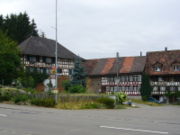
Amlikon
Encyclopedia

Switzerland
Switzerland name of one of the Swiss cantons. ; ; ; or ), in its full name the Swiss Confederation , is a federal republic consisting of 26 cantons, with Bern as the seat of the federal authorities. The country is situated in Western Europe,Or Central Europe depending on the definition....
.
History
In 1995 the municipality was merged with the other, neighboring municipalities BisseggBissegg
-History:In 1995 the municipality was merged with the other, neighboring municipalities Amlikon, Griesenberg and Strohwilen to form a new and larger municipality Amlikon-Bissegg.It was first recorded in year 1324 as Bynssegge....
, Griesenberg
Griesenberg
Griesenberg is a village and former municipality in the canton of Thurgau, Switzerland.-History:In 1995 the municipality was merged with the other, neighboring municipalities Amlikon, Bissegg and Strohwilen to form a new and larger municipality Amlikon-Bissegg.It was first recorded in year 1256 as...
and Strohwilen
Strohwilen
Strohwilen is a village and former municipality in the canton of Thurgau, Switzerland.In 1995 the municipality was merged with the other, neighboring municipalities Amlikon, Bissegg and Griesenberg to form a new and larger municipality Amlikon-Bissegg....
to form a new and larger municipality Amlikon-Bissegg
Amlikon-Bissegg
Amlikon-Bissegg is a municipality in the district of Weinfelden in the canton of Thurgau in Switzerland.The municipality was created on 1 January 1995 by a merger of Amlikon, Bissegg, Griesenberg and Strohwilen.-History:...
.
It was first recorded in year 1282 as Amlikon.
During the High Middle Ages
High Middle Ages
The High Middle Ages was the period of European history around the 11th, 12th, and 13th centuries . The High Middle Ages were preceded by the Early Middle Ages and followed by the Late Middle Ages, which by convention end around 1500....
it was part of the lands of the Baron of Bussnang. From the mid-13th Century until 1798, it was part of the court of Griesenberg, which came from a side line of the Bussnang family. Amlikon has always been part of the parish
Parish
A parish is a territorial unit historically under the pastoral care and clerical jurisdiction of one parish priest, who might be assisted in his pastoral duties by a curate or curates - also priests but not the parish priest - from a more or less central parish church with its associated organization...
of Bussnang. The ferry over the Rhine in Amlikon, was first mentioned in the 14th Century. It was replaced around 1727 by a bridge. The flood of 15 June 1910 destroyed the covered bridge that had been built in 1821. It was replaced in 1911-12 by an iron structure, which was replaced in 1995 by a concrete bridge. The municipality lies on both sides of the Thur River.
Until the 19th Century the main economic activities were grain cultivation in a three-field system
Crop rotation
Crop rotation is the practice of growing a series of dissimilar types of crops in the same area in sequential seasons.Crop rotation confers various benefits to the soil. A traditional element of crop rotation is the replenishment of nitrogen through the use of green manure in sequence with cereals...
and hemp production. This was mostly replaced in the 19th Century by cattle and dairy farming. The first cheese factory was built in 1908. Wine grapes are cultivated today. In the 19th Century there was an oil press. The steep lane to the village was replaced in 1832 by the S-shaped village street. At the turn of the 20th Century there were several local embroidery shops. However, larger factories did not permanently settle in the village.

